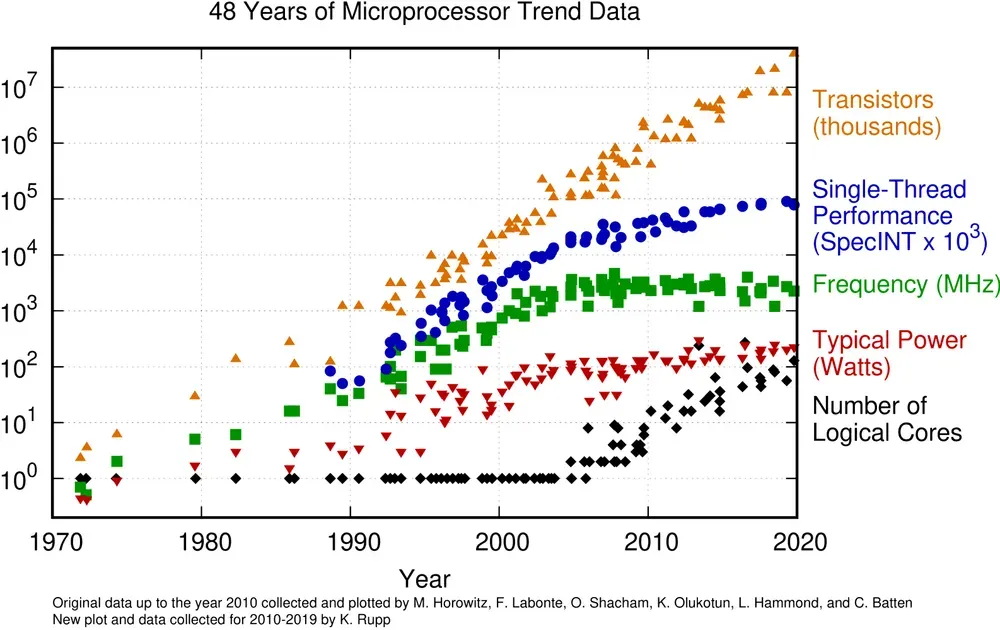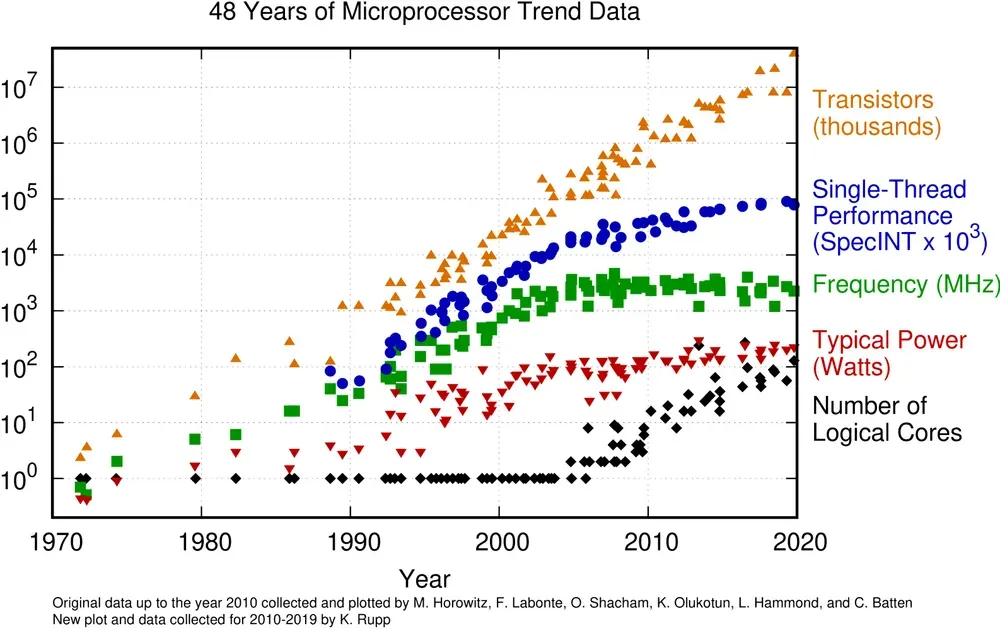Semiconductor Manufacturing in Low-Earth Orbit: A Paradigm Shift in Yield Optimization

The semiconductor industry has been relentlessly pursuing Moore's Law for decades, constantly pushing the boundaries of what's possible in chip manufacturing.

Despite extraordinary advancements in fabrication technology, terrestrial manufacturing faces increasingly formidable physical constraints. As we approach process nodes below 2nm, the conventional challenges of yield management become exponentially more complex.
The core insight behind space-based semiconductor manufacturing is elegantly simple yet revolutionary: what if we could eliminate the very environmental variables that limit yield in the first place?
Earth's environment introduces numerous uncontrollable variables into the manufacturing process: vibrations from seismic activity (even minor ones imperceptible to humans), gravitational effects on fluid dynamics during various processes, atmospheric contaminants that persist despite billion-dollar cleanroom investments, and electromagnetic interference. These factors become increasingly problematic as feature sizes shrink to atomic scales.

The Microgravity Advantage: Beyond Conventional Yield Improvement Techniques
Conventional yield improvement methodologies on Earth focus on elaborate workarounds for problems that simply wouldn't exist in space:
1. Unprecedented Crystal Perfection Through Microgravity Growth
Semiconductor crystals grown in microgravity environments demonstrate remarkable structural perfection compared to their terrestrial counterparts. On Earth, even the most controlled crystal growth processes suffer from convective flows and sedimentation that create microscopic defects. These defects serve as nucleation points for various failure mechanisms during device operation.
Research aboard the ISS has demonstrated that semiconductor materials like gallium arsenide (GaAs) grown in microgravity exhibit dislocation densities orders of magnitude lower than Earth-grown equivalents. This translates directly to higher carrier mobility, lower leakage currents, and ultimately, superior device performance. For power semiconductors like silicon carbide (SiC), microgravity growth could potentially eliminate the micropipe defects that currently limit their performance and reliability.
2. Perfect Dopant Distribution: The Holy Grail of Semiconductor Physics
The precise control of dopant concentration and distribution remains one of the most challenging aspects of semiconductor manufacturing. In terrestrial environments, gravitational effects cause dopant segregation and non-uniform distribution during both crystal growth and implantation processes.
Microgravity enables an almost perfectly uniform dopant distribution, creating the possibility of atomically precise doping profiles that would revolutionize transistor performance. The implications for quantum computing applications are particularly profound, where exact dopant positioning could dramatically improve qubit coherence times.
3. Ultra-Pure Deposition Processes: Beyond Earth's Contamination Limits
Chemical vapor deposition (CVD) and physical vapor deposition (PVD) processes—fundamental to semiconductor manufacturing—achieve extraordinary levels of purity on Earth. However, even in Class 1 cleanrooms, trace atmospheric contaminants remain unavoidable.
In the vacuum of space, with containerless processing enabled by acoustic or electromagnetic positioning, deposition processes could achieve unprecedented purity levels. This would be transformative for sensitive devices like high-electron-mobility transistors (HEMTs) and superconducting circuits, where single atomic impurities can significantly degrade performance.
4. Perfect Lithography: Eliminating Gravitational Lens Distortion
Advanced lithography systems already correct for minute gravitational sagging of optical components and substrates. In microgravity, these corrections become unnecessary, potentially enabling simpler optical systems with even higher precision. The stable vacuum environment also eliminates refractive index variations caused by atmospheric pressure fluctuations, allowing for more precise optical paths.
Economic Viability: The Shifting Calculus of Space Manufacturing
The immediate reaction to space-based semiconductor manufacturing is often focused on cost: "Wouldn't a space fab be prohibitively expensive?" This perspective, while reasonable, fails to consider several key economic factors:
1. Dramatically Falling Launch Costs
SpaceX's Starship program is projected to reduce launch costs to potentially less than $10 per kilogram to LEO—a 100x reduction from historical costs. Blue Origin, Rocket Lab, and other competitors are driving similar cost reductions. This fundamental shift in access economics changes the entire calculation for space-based manufacturing.
2. Value-to-Weight Ratio of Semiconductors
Advanced semiconductor devices have among the highest value-to-weight ratios of any manufactured goods—often exceeding $10,000 per gram for cutting-edge chips. Even with today's launch costs, the transportation cost represents a small fraction of the final product value for high-end semiconductors.
3. The Yield Economics Breakthrough
The most compelling economic case comes from yield improvements. For cutting-edge process nodes where yields might currently be 60-70%, even a 15% absolute yield improvement would represent a 20-25% effective capacity increase. For a fab costing $20+ billion, such yield improvements translate to billions in effective capital savings.
For specialized applications like radiation-hardened chips for space applications, military systems, and medical devices, the yield improvements could be even more dramatic, potentially turning economically nonviable processes into highly profitable ones.
The Technological Pathway: From Experiments to Full Production
The transition to space-based semiconductor manufacturing will likely follow a phased approach:
Phase 1: Specialized Process Steps (2025-2035)
Initial commercial applications will focus on specific high-value process steps performed in space. Crystal growth for specialized substrates like SiC, GaN, and diamond semiconductors is likely to lead the way, as these materials suffer most from gravitational effects during growth and command premium prices. Small-scale epitaxial growth experiments on the ISS have already demonstrated the potential.
The Axiom Space station modules, scheduled to begin operation within this timeframe, could host the first commercial semiconductor processing facilities focusing on these specialized applications.
Phase 2: Small-Scale Integrated Manufacturing (2035-2045)
As in-space infrastructure expands, we'll likely see the first end-to-end manufacturing of specialized semiconductor devices. These will focus on high-value, low-volume applications where the space manufacturing premium is justified by unprecedented performance or capabilities:
- Ultra-high-efficiency solar cells for space applications
- Radiation-hardened computing systems
- Quantum computing components requiring atomic precision
- Novel wide-bandgap power semiconductors
These facilities would be modular attachments to commercial space stations, with automated processing to minimize crew involvement.
Phase 3: Large-Scale Commercial Manufacturing (2045-2060)
The true inflection point will come with purpose-built orbital manufacturing facilities—essentially space factories dedicated to semiconductor production. These facilities would likely be largely automated, with human presence required primarily for maintenance and oversight.
Key enabling technologies will include:
- Fully automated wafer handling in microgravity environments
- In-space recycling systems for process chemicals
- Space-hardened versions of advanced lithography systems
- Specialized robotics for cleanroom operations in microgravity
Novel Materials and Devices: Beyond Current Technological Horizons
Perhaps most exciting are the new classes of semiconductor materials and devices that could become possible in space manufacturing environments:
1. Perfect Topological Insulators and Quantum Materials
Topological insulators and similar quantum materials require extraordinary structural perfection to exhibit their unique properties. Current manufacturing limitations on Earth have restricted their practical applications. Space manufacturing could overcome these limitations, enabling practical quantum computing architectures based on topological qubits—potentially solving the decoherence problems that plague current quantum computing approaches.
2. Three-Dimensional Integrated Circuits with Perfect Vertical Integration
Current 3D chip stacking technologies are limited by gravitational effects during manufacturing that affect alignment precision and interconnect formation. In microgravity, truly three-dimensional circuit architectures become possible, with vertical integration not limited to simple stacking but extending to true 3D circuit layouts. This could lead to computing architectures with dramatically reduced signal propagation distances and power consumption.
3. Ultra-Wide Bandgap Materials for Power Electronics Revolution
Diamond semiconductors and aluminum nitride (AlN) promise extraordinary performance for power electronics but are exceptionally difficult to manufacture on Earth due to the extreme conditions required for their synthesis. Space manufacturing could make these materials commercially viable, enabling power electronic systems with 10x higher efficiency than current silicon carbide technology.
Strategic Implications: National Competitiveness and Security
The nation or corporate entity that first masters large-scale space-based semiconductor manufacturing will gain a significant competitive advantage. This represents a convergence of two strategic domains—space technology and semiconductor manufacturing—that are already recognized as vital to national security and economic competitiveness.
Countries with advanced space programs and semiconductor industries—particularly the United States, China, Japan, and the European Union—are likely to view space-based semiconductor manufacturing as a strategic imperative. We may see government-backed initiatives similar to the CHIPS Act specifically targeting space manufacturing capabilities.
Environmental Considerations: The Sustainability Paradox
Interestingly, space-based semiconductor manufacturing presents a sustainability paradox. The energy requirements for launch appear environmentally costly in the short term. However, the potential for perfect manufacturing with near-100% yields, elimination of many hazardous chemicals currently required to compensate for terrestrial limitations, and the possibility of space-based solar power to run these facilities could actually make space manufacturing environmentally superior in the long term.
Additionally, the perfect semiconductor devices produced could enable significantly more efficient energy technologies on Earth, creating a net positive environmental impact despite the upfront carbon cost of launch.

Conclusion: A New Industrial Frontier
The microgravity environment of Low-Earth Orbit offers a unique solution to the fundamental physical limitations currently challenging semiconductor manufacturing. As launch costs continue to decline and space infrastructure expands, we are approaching an inflection point where space-based manufacturing becomes not just technically feasible but economically compelling for high-value semiconductor applications.
The first commercial applications will focus on specialized materials and devices where the space manufacturing premium delivers extraordinary value. Over time, as costs decrease and capabilities increase, we may see a gradual migration of advanced semiconductor manufacturing processes to orbital facilities.
This represents not just an incremental improvement to existing manufacturing techniques, but a fundamental paradigm shift—one that could reshape the semiconductor industry and enable technologies currently beyond our reach. The perfect crystals, flawless dopant distributions, and contamination-free processes possible only in microgravity may unlock the next several generations of Moore's Law scaling that would be physically impossible to achieve on Earth.
As we stand at the intersection of two of humanity's most advanced technological domains—semiconductor manufacturing and space access—we glimpse a future where the ultimate high ground isn't just a military or communications platform, but the foundation of our most advanced manufacturing capabilities.
The question is no longer if semiconductor manufacturing will move to space, but when, and which visionary companies or nations will lead this next industrial revolution.


![[STA] Synchronous Clocks vs. Asynchronous Clocks](https://images.unsplash.com/photo-1533749047139-189de3cf06d3?crop=entropy&cs=tinysrgb&fit=max&fm=jpg&ixid=M3wxMTc3M3wwfDF8c2VhcmNofDF8fGNsb2NrfGVufDB8fHx8MTc1NTQzMzg1OHww&ixlib=rb-4.1.0&q=80&w=600)

